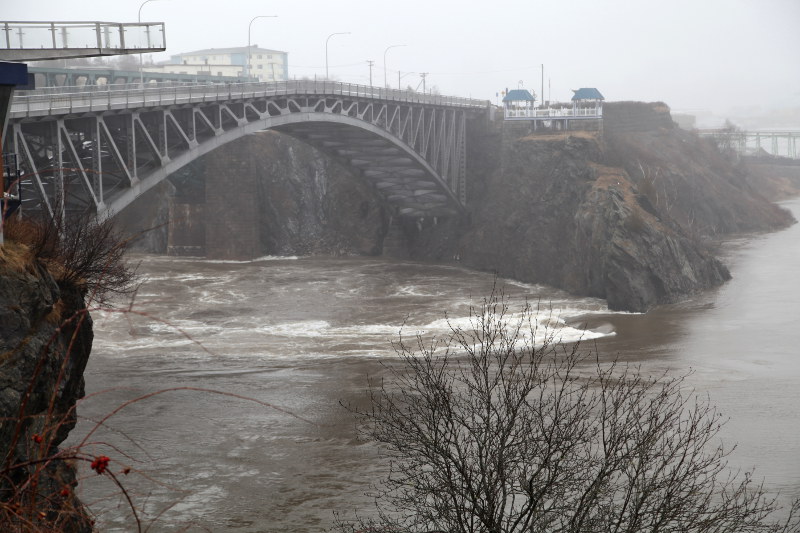The Reversing Falls in St. John are not actually falls… but rather rapids. They reverse flow twice daily because of the powerful rise and fall of the tides of the Bay of Fundy.
There are so many historical facets to the Reversing Falls in St. John that it would be a shame to just focus on just the tourist stop. That said, we stopped at the tourist stop. We stood in the rain. We saw the water reverse. We left because it was cold.
The Reversing Falls has long been a St. John tourist destination. Even in 1941, Tourism New Brunswick purchased ad space in the Montreal Gazette in hopes of drawing people to the site (clipping from June 21, 1941).
Back then, a streetcar carried people between the city’s East and West sides; and, there was an old suspension bridge. Now you can experience the falls via zipline.
But, long before bridges and streetcars and ziplines, this was an important Aboriginal Canadian site. If you grew up on the Bay of Fundy, you’re familiar with the Mi’kmaq stories of Glooscap (the Creator) and how he chased Beaver all over the Maritimes… in an attempt to undo the damage done by the animal.
One such story involves the falls. Beaver built a dam at the location of the rapids that stopped the flow of water. In retaliation, Glooscap cleaved the dam apart with a club.
During the destruction, a piece of earth flew into the air and landed in the Bay of Fundy. This piece of earth became what is now known as Partridge Island.
Partridge Island has a link back to the Wheaton family (previous posts). During an American privateer raid on St. John during the Revolutionary War (1780), a loyalist named Caleb Wheaton (Lieutenant in the Royal Guides and Pioneers) drove hiding Americans off the island.
Subsequently, Wheaton was granted land in Antigonish for his loyalty.
Five years later (1785), Partridge Island became the first port of entry, quarantine station, and pest house for immigrants coming to North America. The station wasn’t fully used until 1816; when an influx of Europeans arrived in Canada after the Napoleonic Wars.
The flow of people later peaked when Irish immigrants came to Canada during the potato famine (1845–1852); in the summer of 1847 alone, 15,000 Irish men and women flooded into Saint John via Partridge Island. This more than doubled the population of the small city and changed economic, religious, and social dynamics. In total, 150,000 Irish immigrants passed through the island in the 19th century.
For those who survived the journey across the Atlantic, Partridge Island was the first and often last place they saw in North America. Without proper housing or medical care, many died during the quarantine. In total, 1200 immigrants are buried on the small island in six separate graveyards.
The land is still considered a strategic military outpost and was actively manned by artillery units during both world wars. It is currently owned and maintained by the Canadian Coast Guard; as such, you need special permission to visit the site.
